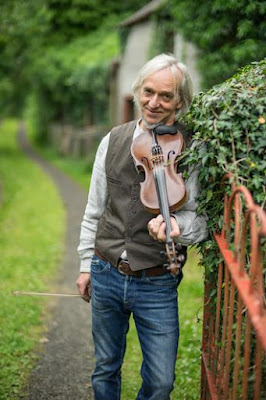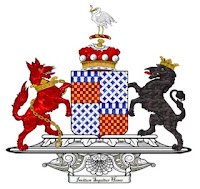SIR GILBERT KENNEDY, one of the hostages delivered to the English in 1357, for the liberation of
DAVID II, King of Scotland.
Sir Gilbert was succeeded by his son,
SIR JAMES KENNEDY, who carried on the line of the family, and obtained from
ROBERT III of Scotland a charter of confirmation of the bailliery of Carrick, and to have the command of the militia of Carrick etc.
Sir James wedded the Lady Mary Stewart, widow of George Douglas, Earl of Angus, and daughter of
ROBERT III, King of Scotland; and got a confirmation from that monarch, then his father-in-law, of the lands and barony of Dalrymple, to himself, and the Princess his wife, dated at Dundonald, 1485.
His eldest son,
SIR GILBERT KENNEDY (
c1406-80), Knight, of Dunure, was elevated to the peerage in the dignity of
Lord Kennedy.
His elder son,
JOHN, 2nd Lord, was father of
DAVID, 3rd Lord, who, being of the Privy Council of
JAMES IV, was, by that monarch, created EARL OF CASSILLIS.
His lordship was slain at Flodden Field, and was succeeded by his son,
GILBERT, 2nd Earl, who filled the high office of Lord Treasurer of Scotland, and assisted, as a deputed Scottish peer, 1558, at the marriage of the ill-fated Mary Stuart, with Francis,
Dauphin of France.
His lordship wedded Elizabeth, daughter and heiress of John Kennedy, of Culzean, by whom he had two sons, Gilbert and Thomas.
He died in 1558, he was succeeded by the elder son,
GILBERT, 4th Earl, who died in 1576 and was succeeded by his son,
JOHN, 5th Earl, who, dying without issue, the family honours devolved upon his nephew,
JOHN, 6th Earl, who died in 1702 and was succeeded by his grandson,
JOHN, 7th Earl, with whom the male branch of this family was extinguished.
Following the 7th Earl's decease, in 1759, and leaving no child, the family honours reverted to
THOMAS, the direct descendant of Thomas, son of Gilbert, the 3rd Earl.
The grandfather of this nobleman, Archibald, was created a baronet in 1682, designated
of Culzean, Ayrshire.
ARCHIBALD, 12th Earl (1770-1846), was advanced to the dignity of a marquessate, in 1831, as MARQUESS OF AILSA.
The heir presumptive is the present holder's younger brother Lord David Thomas Kennedy (b 1958), married with a son.
CULZEAN CASTLE, near Maybole, Ayrshire, is one of the most splendid houses in Scotland.
Built between 1775-92, its designer was Robert Adam, perhaps the most creative late Georgian architect.
Adam was commissioned by the 10th Earl of Cassilis to enlarge and remodel a late 16th century castle, set on a cliff-top overlooking the sea. Its pepper-pot turrets, towers and battlements borrow directly from historic Scottish architecture.
The Castle's rounded towers, set with arrow slits, make the façades bulge in and out.
However, the front is rigorously symmetrical, unlike most medieval castles.
Apart from the arrow slits, the windows are regular Georgian sashes, and evenly spaced.
There are even classical columns framing the large central windows.
It incorporates a large drum tower with a circular saloon inside (which overlooks the sea), a grand oval staircase and a suite of well-appointed apartments.
Inside, all is made clear: the stunning interiors are Neo-Classical.
In 1945, the family gave the castle and its grounds to the National Trust for Scotland (thus avoiding inheritance tax).
In doing so, they stipulated that the apartment at the top of the castle be given to General Dwight D Eisenhower in recognition of his role as Supreme Commander of the Allied Forces in Europe during the 2nd World War.
Eisenhower first visited Culzean Castle in 1946 and stayed there four times, including once while US President.
An Eisenhower exhibition occupies one of the rooms, with mementoes of his lifetime.
The Ayrshire (Earl of Carrick's Own) Yeomanry, a yeomanry cavalry regiment, was formed by Lord Cassillis at Culzean Castle
ca 1794.
In 1961, the Regiment returned to the castle to be presented with its first
guidon by General Sir Horatius Murray
KBE CB DSO.
The castle re-opened in April, 2011, after a refurbishment funded by a gift in the will of the American millionaire William Lindsay to the National trust for Scotland.
Lindsay, who had never visited Scotland, requested that a significant portion of his $4 million go towards Culzean.
Mr Lindsay was reportedly interested in Eisenhower's holidays at the castle.
CASSILLIS HOUSE, near Kirkmichael, Ayrshire, was another seat of the Earls of Cassillis.
The mansion featured in a BBC series,
Restoration Home.
The house was sold by Lord Ailsa in 2009.
First published in November, 2013. Ailsa arms courtesy of European Heraldry. 




























